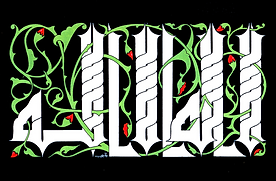
Classic Arabic Calligraphy
By:
M.J. Alhabeeb
Thuluth:
Thuluth is one of the earliest and most original scripts.
Historically, it was written with a pen, the nib of which
measured one-third as wide as the nib of the earlier
Tumar pen, hence the name, as it means one-third in
Arabic. Thuluth script is rich, majestic, and imposing.
It is considered the most difficult to master, and
therefore, the skill of its writing can practically serve
as the best criteria to reflect the artistic talent of a
calligrapher, and how experienced he is. It has been
known for centuries that if a calligrapher wants to prove
his competence, he would have to be able to master the
Thuluth script. One major reason for such a stature for
this script is its natural structure and the way it is laid
out which lend themselves to higher plastic qualities and
more cohesive aesthetic form. It is no wonder that the
Thuluth Script has been considered "the mother of all
scripts".
Kufi:
The Kufi script is named after the ancient city of Kufa
in Iraq, where it was originated. It is also one of the
earliest scripts. It is distinguished by its mathematical
proportions and complex geometry. This characteristic
has made it amenable to soaring creativity and has
widen its applications, especially on large surfaces and
elaborate constructions such as the architectural
installations. Because of its highly ornamental nature,
this script has been naturally attuned with the use of
Arabesque in all of its applications from paperwork and
metalwork to pottery and tiles. The Kufi script comes
in many styles. The most famous of these styles are
the foliated, braided, twisted, squared, circular, as well
as eastern and western.
Diwani:
The Diwani script was not among the very early scripts.
It was developed by the Ottoman Turks in the late 15th
century. According to Safadi (1992), its invention was
attributed to Ibrahim Munif, while further refinments
were credited to Shaikh Hamadulla Al-A'masi. It was
originally utilized for secretarial and governmental uses.
Later on, it became heavily cursive and dramatically
interlaced. The development of the Jeli-Diwani, which
is an ornamental variety of this script, was attributed
to Alhafuth Othman. It is distinguished by its intricate
elastic stretches of the letters, and the heavy use of
the diacritical marks, as well as a great amount of
ornamental dots, which are used to fill the spaces
around the letters.
Ta'leeq:
The Ta'leeq script was developed by the Ottmans in
Persia at the beginning of the 9th century. It is known
by its graceful curveswhich flow enchantingly like a
snake slithering through the sand. It is lusterous,
glamorous, and captivating like a romantic melody.
Naskh:
Naskh is also one of the earliest scripts. It possesses
a special air of esteem that made it so admirable to
dominate the writing of the Qura'n for centuries.
It has also been widely used in day to day needs of
written communication. This script enjoys an optimal
combination of artistic and functional characteristics
no other script can claim. This is probably the reason
that Naskh cannot be cursive or interlaced.
It is designed with deliberate simplicity and vivid
straightforwardness, a unique feature that makes it
radiate with beauty and charm.
Riq'aa:
Like Naskh, Riq'aa was designed to be plain and
straightforward to be functional first and for most.
But unlike Naskh, this script remained free of any
diacritical marks. It is recognized by its bold and
compact structure. Its letters are short and curvy
with sharp edges and ends. The plain beauty of
this script qualified it to be the model for the
most charming handwriting. It should be noted
here that this Riq'aa is not the same as the very
early script of the six pens, which was spelled
slightly different as Riqaa'.
Other Scripts:
Other scripts include Muhaqaq and Rihani, which
are slightly different looking twins to Thuluth.
They also include a variety of the very early
Thuluth, in addition to the Tughra'i, which is
also known as Tawqee or signature.







Major Scripts

© 2012 by SAMANTA JONES
